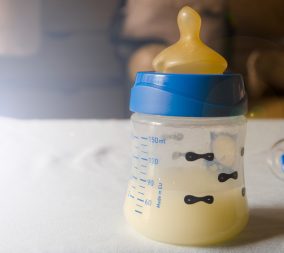A question that has been increasingly coming up in the office is, “Should I be collecting colostrum before my baby is born?” Antenatal colostrum collection refers to expression and storage of early breast secretions prior to delivery. The rationale for doing this is to prepare ahead of time in case there is delayed milk production, need for supplementation of early nursing, or blood sugar concerns for baby. Antenatal colostrum collection has also been found to improve breastfeeding confidence and continuation in some studies. The pregnant patients who may benefit the most from antenatal colostrum collection are those with pregestational or gestational diabetes. Infants of diabetic mothers are more likely to experience low blood sugar levels, which frequently require treatment with additional milk or glucose. If the mother has colostrum to provide, this can often be used instead of formula or glucose to treat their baby’s low blood sugar.
The transition from colostrum to breastmilk is commonly referred to as “milk coming in.” This usually occurs three to five days postpartum but can be delayed for a variety of reasons. Women who have a long labor induction, cesarean delivery or who have certain pregnancy complications are more likely to have delayed milk production. In these situations, it can be helpful to have a stash of previously collected colostrum on hand to provide supplementation while waiting for milk production to pick up.
Because nipple stimulation causes oxytocin release (and oxytocin promotes uterine contractions), it has been suggested that antenatal colostrum expression could lead to preterm labor. The data regarding if antenatal colostrum expression leads to preterm labor is mixed. However, the largest and most well-designed study on the topic demonstrated no difference in delivery timing between women who expressed colostrum between 34 and 37 weeks and those who did not. This study randomized 635 women with diabetes in pregnancy to expressing colostrum between 34 and 37 weeks or standard of care. The authors found no difference in gestational age at birth or NICU admission between the groups. This is reassuring, but more research is still needed. For low-risk patients, the conservative thing to do is to wait until 37 weeks to begin expressing colostrum. That way, in the unlikely case that it pushes you into labor, your baby is at least term (“term” pregnancy is defined as 37-41 weeks).
When in doubt, talk to your OB provider. It is important to review your particular pregnancy and health history before deciding if expressing colostrum before your baby is born makes sense and is safe. For example, patients with certain placental conditions (like placenta previa) and those who have had bleeding during their pregnancy would not be good candidates for antenatal colostrum collection.
So how does one go about expressing and collecting colostrum anyways?
- Wash your hands thoroughly
- Make a “C” with your thumb on top of your breast and your forefingers underneath
- Push the “C” of your hand towards your chest wall and then compress your breast towards the nipple
- Repeat step 3 for a couple of minutes, collecting colostrum as it is expressed; perform steps 1-4 on the other side; stop if you notice contractions or vaginal bleeding
- Collect and store colostrum in a clean, food-safe syringe or container
Safe storage: Label with date of collection. Colostrum can be kept at room temperature for 4 hours, in the fridge for 4 days, and in the freezer for 6 months.
Antenatal colostrum collection can be a helpful tool to aid in the newborn transition and increase confidence with lactation. It is not however something that you should feel you have to do! Late pregnancy can be a busy and tiring time, so don’t let this be another task to add to the to-do-list. If it is something you are interested in and think would be stress relieving, by all means give it a go.
References:


















